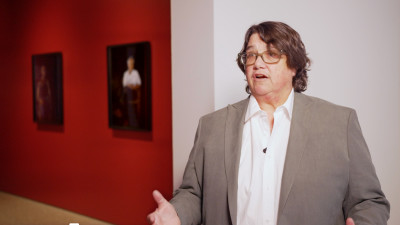How to read it: Annie Swynnerton’s The Letter
By RA Collections team
Published 15 July 2020
In 1922, the Royal Academy elected its first female member in over 150 years, Annie Swynnerton – here’s how to read her enigmatic painting of a young woman.
-
-

An earlier version of this article was published in March 2018.
Is this a portrait?
Maybe. The pioneering Victorian artist Annie Swynnerton was a successful portrait painter – she was a member of the Royal Society of Portrait Painters and her sitters included the author Henry James and leading Suffragist Millicent Fawcett – but this painting is notably different to those works. Portraits of the era tended to show the subject looking directly at the viewer, but the girl in this painting is shown in profile, absorbed in reading a letter. Although we don’t know who the sitter was, there are some clues in the painting – her clothing, for instance, indicates that she belongs to a wealthy family.
What is she reading?
We don’t know! While frustrating, this is true of many well-known paintings that depict people reading letters. The most famous example is probably Vermeer’s Woman Reading a Letter, which like The Letter shows a woman in profile to the left, reading by the light flowing through a window from that direction.
In both these paintings, we observe people responding to personal correspondence with the implication that it might be of great significance to them. Since we don’t know what the letter says, we’re left to imagine its message for ourselves.
Who was Annie Swynnerton?
An internationally acclaimed painter and passionate campaigner for women’s rights, Swynnerton co-founded the Manchester Society of Women Painters and supported the Women’s Suffrage movement. Born in Manchester in 1844, she began her artistic training at the Manchester School of Art, where women were still banned from drawing nude models, before travelling to Paris and Rome, where she was able to study life drawing.
She exhibited at the Royal Academy from 1879 and her work was championed by Academicians including John Singer Sargent, who bought her painting Oreads and presented it the Tate Gallery in 1922. The same year, Sargent and another collector of Swynnerton’s work, George Clausen, nominated Swynnerton for membership to the RA.
However, due to Swynnerton’s age at the time – 78 – she was made a “retired Associate”, meaning she played no active role in Academy affairs. She died in 1933, three years before the RA finally elected its first female Academician, Laura Knight. In Knight’s autobiography, she wrote:
-
-
We women who have the good fortune to be born later than Mrs Swynnerton profit by her accomplishments. Any woman reaching the heights in the fine arts had been almost unknown until Mrs Swynnerton came and broke down the barriers of prejudice.
Dame Laura Knight
-
Why is the painting so narrow?
From her time in Rome, Swynnerton would have been familiar with Italian Renaissance altarpieces, which often featured slender side panels depicting individual saints. These panels may have influenced her decision to make this unusually narrow work. The dimensions create a claustrophobic atmosphere, in which the girl appears trapped by the confines of the canvas. Given Swynnerton’s strong support for the suffrage movement and the advancement of female artists, it’s tempting to interpret this formal decision as a metaphor for the limited options available to young women and the consequences of such inequality.
How has she been celebrated recently?
In February 2018, Manchester Art Gallery opened the first retrospective of Swynnerton’s work for nearly a century. It was a fitting location, since Swynnerton’s first and only major exhibition in her lifetime was also held at the gallery, in 1923. The exhibition included a number of works left to the gallery by Swynnerton herself, as well as The Letter, on loan from the Royal Academy. The year after her death, the RA Council was given the opportunity to purchase The Letter from its original buyer. The decision was approved unanimously.
-
In 60 Seconds: Swynnerton's ‘The Letter’
Discover Annie Swynnerton ARA’s The Letter in 60 Seconds, with this quick video primer.
-
return to start
Start exploring the RA Collection
read more- Explore art works, paint-smeared palettes, scribbled letters and more...
- Artists and architects have run the RA for 250 years.
Our Collection is a record of them.




